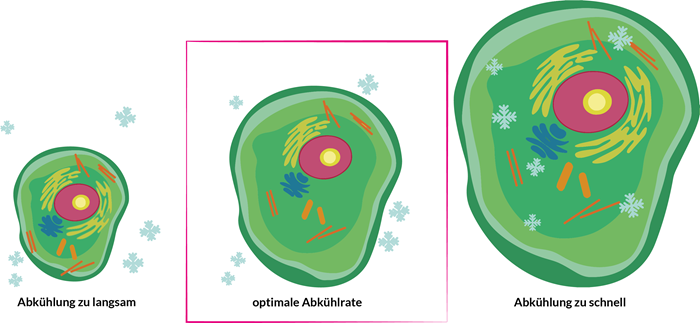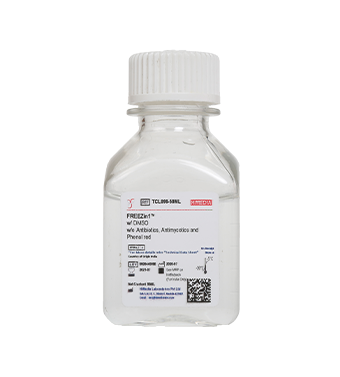Cryopreservation of human and animal cells
The goal of cryopreservation is to safely store cells for long periods of time without the risks of microbial contamination, cross-contamination (with other cell types), genetic drift or morphological changes. It also circumvents the problem of cellular senescence (aging): Many cells do not divide indefinitely in culture and die over time. By freezing the cells, this process is interrupted.
At very low temperatures (we are talking about -150 to -196°C!), any enzymatic or chemical activity is effectively stopped and the biological material remains genetically stable and metabolically inert. Cryopreservation is thus a central process in all cell culture laboratories. A well-organized and properly established cell bank guarantees the laboratory a continuous supply of functional cell lines and serves as a backup in case something goes wrong with the experiments.
What should be considered when freezing cells?
The cells to be preserved should of course be as vital as possible in order to be able to cope with the process of freezing and thawing in the best possible way. Therefore, cells that have reached the exponential growth phase are optimally used. The cell density at which the cells should be preserved varies with the cell types; however, it should generally be neither too low nor too high.
Cell preservation is performed in special freezing or cryo media. These media classically consist of the respective standard culture medium enriched with serum (FBS) and cryoprotectants. However, there are now excellent ready-to-use formulations that do not contain serum and other animal components, and some of them are even chemically defined. One such medium is FREEZin1™.
To maintain maximum viability during cryostorage, cells should be cooled down at a constant rate of -1°C per minute. This controlled cooling rate can significantly reduce two cell-damaging events: Irreversible dehydration of cells (resulting in cell-damaging increase of intracellular electrolytes) and intracellular ice crystal formation.
The correct freezing rate is essential to strike a balance between these two problems: low, reversible dehydration of the cells and the formation of exclusively extracellular ice crystals.
Antifreezing agents protect cells from mechanical and physical stress during freezing.
Penetrating cryoprotectants such as DMSO and glycerol reduce the water content in the cells, minimizing the formation of intracellular ice crystals. At the same time they prevent osmotic dehydration of the cells and thus avoid high electrolyte concentrations inside the cells.
Non-cellular cryoprotectants such as trehalose and sucrose improve the osmotic imbalance and play an important role especially at high cooling rates and the thinning phase (removal of glycerol from the cells) during thawing.
In contrast to the freezing process, speed is required for thawing: the cell-damaging effect of cryoprotectants is minimized by rapid thawing at 37°C and immediate dilution with medium. If it is necessary to centrifuge the cells, they should be sedimented with the minimum g-force to avoid shear damage.

Successful cryopreservation depends crucially on the kinetics of cooling down:
If the freezing rate is too slow, irreversible dehydration (hypertonic solution effect; damage caused by excessively concentrated electrolytes) of the cells takes place (image on the left).
If, on the other hand, the freezing rateis too fast, the residual water can form cell-damaging intracellular ice crystals (right).
Only at an optimal freezing rate ice crystal formation does occur exclusively externally and the cell dehydration is moderate and reversible (middle).
Our recommendation: FREEZin1™
FREEZin1™ is a serum-free and chemically defined freezing medium for established cell lines, primary cells and stem cells. FREEZin1™ is manufactured under cGMP conditions and combines user-friendliness (ready-to-use) with excellent performance. Especially sensitive cell types benefit from the outstanding recovery rates.
- Ready to use
- Ideal for serum-free applications and clinical studies
- No batch variations due to chemically defined composition
- Excellent performance in terms of viability, proliferation, adherence and bioactivity after thawing
- Suitable for MSCs: maintenance of pluripotency and high growth rate after thawing
- Optimized and tested for a variety of cell types such as T cells, beta cells, hybridomas, human endothelial cells, mesenchymal stem cells, blood cells (umbilical cord; PBMCs), and established mammalian cell lines (CHO, MRC-5, HEK-293, HepG2, HeLa, BSC-1, BGM, 3T3, MA-10, BHK-21, B16-F10)

